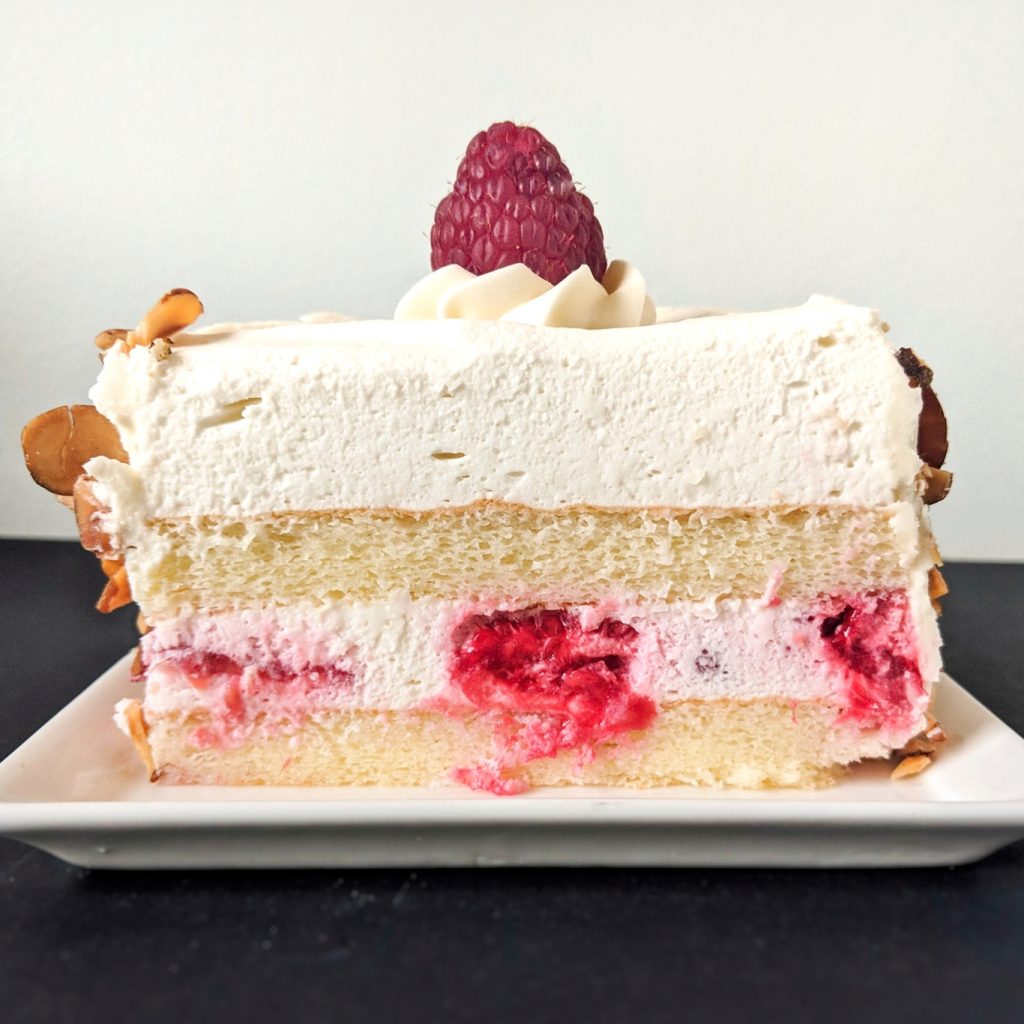The inspiration for our Tokaji (pronounced “toe-kai”) Cream Cake comes from the Auguszt Pavillion bakery in Budapest, home to one of the city’s oldest baking families. Now in its fifth generation, the Auguszt family of bakers have taught us important lessons about traditional Hungarian pastries. This distinctive cream torta is their lesson to us in a more modern direction. They have continued to evolve their craft and if you visit their bakery, you’ll see many new creations, including a Tokaji Cream Cake.

Our version of this modern Hungarian cream cake is elegant, light, fresh, and pretty. And, it includes a key ingredient of any Tokaji Cream Cake—Tokaji Aszú, the famous Hungarian sweet dessert wine.
More about Tokaji Aszú wine

Tokaji Aszú, a sweet white wine with a rich golden hue, hails from Tokaj in Hungary. It’s the oldest, yet one of the smallest, classified wine regions in Europe. Vineyards abound in the misty valley where two slow-moving rivers, the Bodrog and the Tisza, meet along the southern slopes of the Zemplén Mountains. Traditional viticulture (grape cultivation) in the region dates back to Roman rule under Diocletian, around 300 AD.
This golden, sweet wine is revered by European royalty, statesmen, popes, and artists throughout the 17th, 18th, and 19th centuries. Wine connoisseurs today, the world over, love it as well. It’s made from aszú grapes of the Furmint variety that have been left on the vines, long past normal harvest time. What makes the wine sweet is a mold called botrytis cinerea. It infects grapes, while still on the vine, when the humidity and climate conditions in the region are right. This causes the berries to darken and shrivel like raisins, concentrating the fruit juice into a luscious, sweet nectar. The phenomenon is called “noble rot” because of its magical effect on the flavor of the grape juice and wine.

Some history of Tokaji Aszú

This cultivating technique of leaving Furmint grapes long on the vine was discovered by accident in the early 17th century. Zsuzsanna Lórántffy (the wife of György Rákóczi I, Prince of Transylvania, and a major landowner in the Tokaj region) and her vineyard manager, László Máté Szepsi, decided to postpone the harvest on the family’s extensive vineyards in the face of the imminent Turkish invasion. By the time they got around to the harvest, the grapes had turned into shriveled botrytized raisins. The winemakers decided to use them anyway, and Tokaji Aszú was born.
By the early 18th century, the wine was the toast of the French royal court in Versailles. So much so, that Louis XV, in offering a glass of the precious drink to his mistress, Madame Pompadour, proclaimed it “Vinum Regum, Rex Vinorum” (“Wine of Kings, King of Wines”). Voltaire, the renowned writer, philosopher, poet, dramatist, historian, and polemicist of the French Enlightenment, was another ardent fan of the wine. He praised it in 1749 with the following accolade: “Tokaji invigorates every fiber of the brain and brings forth an enchanting sparkle of wit and good cheer from the depths of the soul.”

Later in the 19th century, Franz Josef I, Emperor of Austria-Hungary, had a tradition of sending Queen Victoria, of Great Britain and Ireland, Tokaji Aszú as a gift. Every year on her birthday, he sent one bottle of wine for every month she had lived. On her penultimate birthday in 1900, she received an impressive 972 bottles. Over the centuries, the wine has also received accolades from some of the world’s greatest writers and composers, among them, Beethoven, Liszt, Schubert, Johann Strauss, Haydn, Goethe, Heinrich Heine, Friedrich von Schiller, and Bram Stoker.
Tokaji Cream Cake at the Bakehouse
In our interpretation, we make the cream filling with the Tokaji wine variety, 5 Puttyonos Aszú, a little sugar, Guernsey whipping cream, and a touch of gelatin. We layer this luscious, wine-infused cream with light vanilla chiffon cake and fresh raspberries. The tart raspberries and the sweet Tokaji Aszú are one of those perfect flavor combinations.
Perhaps our Tokaji Cream Cake will turn you into a fan of Tokaji Aszú, too. Kérjük, élvezze! (Please enjoy!)
After a long, established career as a Ph.D. art history scholar and art museum curator, Lee, a Michigan native, came to the Bakehouse in 2017 eager to pursue her passion for artisanal baking and to apply her love of history, research, writing, and editing in a new exciting arena. Her first turn at the Bakehouse was as a day pastry baker. She then moved on to retail sales in the Bakeshop, followed by joining the Marketing Team and becoming the Bakehouse’s designated culinary historian. In addition to her retail sales and marketing work, she’s a member of the Bakehouse’s Grain Commission, co-author and editor of the Bakehouse's series of cookbooklets, and a regular contributor to the BAKE! Blog and Zingerman’s Newsletter, where she explores the culinary, cultural, and social history and evolution of the Bakehouse’s artisan baked goods.



